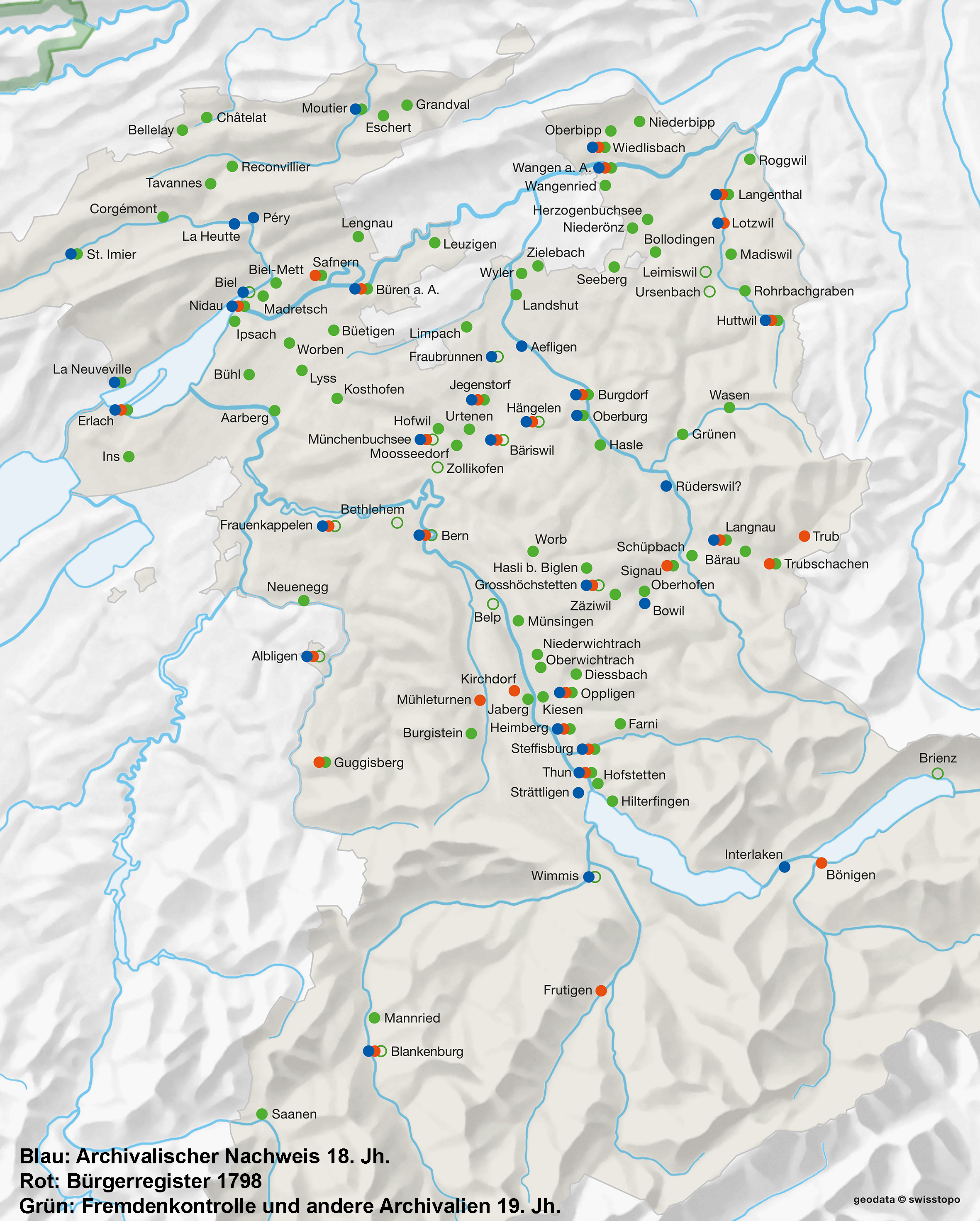
Places of pottery production in the Canton of Bern according to archival records.
Andreas Kistler, Andreas Heege, 2021
Various archival records can be found in the Canton of Bern (mainly in the State Archive of Bern StAB) that contain references to potters. Records from the 16th and 17th centuries are rather scarce (mainly referring to urban potters). The 18th century, Bern’s “Golden Period”, is covered by the accounts for the Bailiwick of Bern. They list all the work that was carried out in state institutions, including bailiffs’ castles, rectories, prebends’ houses etc. This also includes the ongoing repairs on tiled stoves or orders for new ones. They provide us with information at least on some potters (but by no means all) who were taking on commissions from the authorities (blue dots on the map). So far, the urban records on potters and the bailiwick accounts have mainly been studied by Adriano Boschetti-Maradi (2006) but a systematic and complete analysis of the sources is still outstanding.
Another source of information are cantonal registers of Bern citizens dating from 1798, which were used to register every individual that had to swear an oath of allegiance to the constitution of the new Helvetic Republic. They have been preserved in full and list the place of origin, name, age and profession of each citizen. They are available in print (Rohrbach 1999). Andreas Kistler used them to compile a list of all potters for 1798 with their years of birth and death which he verified wherever possible (red dots on the map).
List of potters in the Canton of Bern according to the 1798 Helvetic Register of Citizens
Thanks to its statutory system of registering foreign (non-Bernese) citizens, the Canton of Bern has another unique source from which to glean information about the craft. While the lists from some offices have not survived, the preserved records nevertheless provide basic information on 19th century pottery making in the Canton of Bern. From 1810 to 1908, every journeyman hailing from another canton or country had to be registered; the information that had to be provided included the journeyman’s place of work, the name of the potter who was going to employ them, how long they were going to work there, and their own name and place of origin. As a result, we now have a list of 19th century potteries (green dots on the map) that were sufficiently profitable to allow for journeymen to be hired. The list also gives an impression of what cantons or where in Austria or Germany the journeymen originated from. In the 19th century, migrant journeymen were the driving force behind the technological and decorative changes that occurred in pottery making and played a considerable part in the formation and spread of “Heimberg type” pottery or “Thun majolica”.
List of Bernese potters employing foreign journeymen in the 19th century (data compiled by Andreas Kistler from the archival records in the StAB)
List of foreign journeymen in alphabetical order (data compiled by Andreas Kistler from the archival records in the StAB)
List of foreign journeymen by country, canton/state, location (data compiled by Andreas Kistler from the archival records in the StAB)
The fourth group of sources that have been systematically analysed so far, though only in respect of certain places or workshops (see Heege 2011; Heege/Kistler/Thut 2011; Heege/Kistler 2017b; Heege/Spycher/Kistler 2020) are the so-called Contractenprotokolle (land registry) of the bailiwicks (up to 1798) and the land registers of the Canton of Bern (from 1798 up to the present). They list (almost) all the changes in ownership. This means that if a potter ever owned a property or site, there is a good chance that he is listed in one of these sources. If, on the other hand, he only leased a workshop, there are usually no sources available. In the best case, the records from this group of sources allow us to compile entire sequences of owners for each individual property or workshop, most of which can then also be pinpointed topographically (example).
The fifth category of sources which has not been systematically analysed to date are the records and stock ledgers of the Bernische Brand-Assekuranz (Bern Fire Insurance) from 1806 onwards, which could include references to insured potters’ properties and kilns.
Translation Sandy Haemmerle
References:
Boschetti-Maradi 2006
Adriano Boschetti-Maradi, Gefässkeramik und Hafnerei in der Frühen Neuzeit im Kanton Bern (Schriften des Bernischen Historischen Museums 8), Bern 2006.
Heege 2011
Andreas Heege, Langenthal, St. Urbanstrasse 40–44. Die Hafnerei Staub und ihre Werkstatt, in: Archäologie Bern/Archéologie bernoise. Jahrbuch des Archäologischen Dienstes des Kantons Bern, 2011, 209-287.
Heege/Kistler 2017b
Andreas Heege/Andreas Kistler, Keramik aus Langnau. Zur Geschichte der bedeutendsten Landhafnerei im Kanton Bern (Schriften des Bernischen Historischen Museums 13), Bern 2017.
Heege/Spycher/Kistler 2020
Andreas Heege/Alfred Spycher/Andreas Kistler, Die Hafner von Hängelen und das Rätsel der Bäriswiler Kachelöfen, in: Gemeindebuch Krauchthal, 2020, 173-256.
Heege/Kistler/Thut 2011
Andreas Heege/Andreas Kistler/Walter Thut, Keramik aus Bäriswil. Zur Geschichte einer bedeutenden Landhafnerei im Kanton Bern (Schriften des Bernischen Historischen Museums 10), Bern 2011.
Rohrbach 1999
Lewis Bunker Rohrbach, Men of Bern: The 1798 Bürgerverzeichnisse of Canton Bern, Switzerland, Rockport 1999.
Schwab 1921
Fernand Schwab, Beitrag zur Geschichte der bernischen Geschirrindustrie (Schweizer Industrie- und Handelsstudien 7), Weinfelden/Konstanz 1921.

